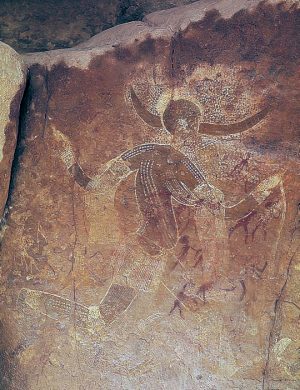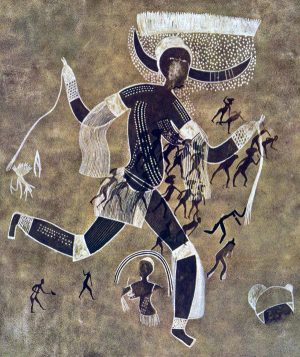Running Horned Women

Running Horned Woman, 6,000-4,000 B.C.E., pigment on rock, Tassili n’Ajjer, Algeria
For my second blog post this week I am going to be kind of tagging along with my first post. In my first post I discussed what “Rock Art” was and all the different details into it, but for this post I am going to be focusing on a single specific piece. The piece I am focusing on is called the Running Horned Women or also known as the Horned Goddess. This piece was also discovered by Lieutenant Brenans of the French Foreign Legion between the years 1933 and 1940. The specific location of this piece is very difficult to hike/climb/crawl to. A sketch of this piece (conducted by Lieutenant Brenans) can be found inside the Bardo Museum in Algiers.
To truly reveal the Horned Goddess, the discoverer used a damp sponge of water, he dabbed the wall consecutively and carefully to reveal this figure. According to smart history, “Perhaps we have here the figure of a priestess of some agricultural religion or the picture of a goddess of such a cult who foreshadow—or is derived from—the goddess Isis, to whom, in Egypt, was attributed the discovery of agriculture.” It is also stated that there is belief that the egyptions had an influence on this creation, rather that’s with the Egyptian gods or a queen of some sort, we don’t know exactly what the influence was specifically. It was noted that the influence by Egyptians was erroneous.
“For so long the search for meaning in rock art was considered inappropriate and unachievable—only recently have scholars endeavored to move beyond the mere description of images and styles, and, using a variety of interdisciplinary methods, make serious attempts to interpret the rock art of the Central Sahara.” according to smart history. This is really interesting because over the last 80 years ish this artwork was not looked at very seriously. It does make sense because there is so much less art work from northern Africa, that it is genuinely hard to truly interpret the actual meaning behind the piece.

Visible in this reproduction of the original rock painting are two groupings in red ochre of small human figures superimposed onto the horned goddess
Smart History link: https://smarthistory.org/running-horned-woman-tassili-najjer-algeria-2/
Hager, Nathalie, and Nathalie Hager. “Running Horned Woman, Tassili N'Ajjer, Algeria.” Smarthistory, smarthistory.org/running-horned-woman-tassili-najjer-algeria-2/.

Hey justin, Great post i think you did a great job on going in depth on the Rock Art in the first post you did, this one i liked how you focused on the art piece its self and there to you did a great job informing us how this piece represents an agriculture religion, very interesting.
ReplyDeleteGood job Justin! I really enjoy the overall design and style that the second image captures. The colors used really compliment the rock that was used as a canvas. Very interesting read!
ReplyDeleteHey Justin! I think you did a really good job at going into depth on the discovery of the Running Horned Woman. The reproduction of the piece is absolutely amazing. I love when art uses white to make the piece pop.
ReplyDelete